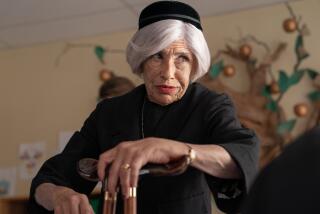Urbanites at Home on the Range
- Share via
There’s wood to be chopped, chores to be done, cows to be milked, petticoats to be scrubbed and grudges to be held on “Frontier House.”
It’s 1883, and three urban families from the 21st century--that’s right, this century--are trying to make it as homesteaders in the rugged Montana Territory.
Fat chance? We’ll see.
From Malibu come the Clunes: business owner Gordon, 41; his wife, Adrienne, 40; daughter Aine, 15; sons Justin, 13, and Conor, 9; and niece Tracy, 15.
From Tennessee come the Glenns: community college teacher Mark, 45; Karen, a 36-year-old school nurse; daughter Erinn, 13, and son, Logan, 9.
From Massachusetts come the Brooks: 28-year-old Nate, a student, and his father, Rudy, 68, who will be replaced by Nate’s 28-year-old fiancee, Kristen, a social worker, set to arrive for the wedding and move in with her new husband.
No cell phones for these time travelers. No electricity and, by pre-agreement, no comforts from home during their scheduled five months in the Old West. No indoor facilities, not one roll of toilet paper. No junk food, not one potato chip. No modern toys, not one Nintendo game. No modern dress, not one pair of jeans or sneakers.
These families signed up to wear period clothes, live in drafty log cabins and exist off the land, their animals and their wits, while hoping to survive in this exquisite wilderness that soon will turn snowy white.
They rise early and tumble into bed at night exhausted, hungry, cold and homesick.
Are they out of their minds or merely out of their element?
It’s not really 1883, of course. Unlike the pioneers they’re imitating, “settlers” here are ringed by TV gear and crews, and they won’t be dying on the prairie. Although nearly on their own, they get a bit of help. Wranglers and carpenters initially pitch in. Plus they get a small stake they can spend, along with limited credit at a general store, a milk cow, a calf, a dog, and permission to buy or trade for other animals and items available in Montana in 1883. And if things get really bad for this trio of families picked from 5,000 applicants, well, look, this is no prison camp. Any one of them can pack it in and go home.
That doesn’t make these six hours of “Frontier House” any less seductive, however. Just try not watching, from close-ups of these neo-adventurers awkwardly straddling Americas of different ages to panoramic views of them as specks against the rolling green majesty of their environment.
And angst? There’s a wagon crisis, a gun crisis, a hunting crisis. There’s a range crisis right out of an MGM western, as our homesteaders scramble to erect fences to keep out cattle about to be driven across their property.
There’s also a cheating crisis when one of the families (all right, it’s the Clunes) brazenly compromises the historical integrity of the series by breaking rules it agreed to follow as a condition for taking part. And yes, there’s even a makeup crisis.
In this prime-time era of “Survivor”-mania, it’s tempting to stamp “clone” on shows that are even vaguely similar to that glossy prototype. Not so, however, with this new PBS three-parter, which begins tonight and continues through Wednesday, whose roots are much less in hokey tribal councils and tailored-for-TV misery than in “The 1900 House,” an earlier PBS series that monitored a contemporary family of Brits living as Victorians.
Two of the same producers, Simon Shaw and Beth Hoppe, are behind “Frontier House,” along with Nicolas Roether Brown and Maro Chermayeff. Like the earlier program, this heroically smart new one is as educational as magnetic, using narration to impart western history as it documents the conflicts and dramatic twists that come with relocating to this beautiful but challenging new habitat.
Unlike the big-bucks competition on greedy, cutthroat “Survivor” and its copies, the only payoff here is the experience. You know, just doing it.
For better or for worse.
You’d expect communal closeness to help these people through hard times. And this tiny settlement does come together occasionally as a unit. Nate, who is black, and Kristen, who is white, have themselves a hoot of a wedding, for instance, as a factoid is delivered to viewers about interracial couples moving west to escape prejudice in the 19th century.
Yet wide cracks swiftly appear in the group’s good-neighbor facade, as “Frontier House” becomes as much about behavior under stress in 2001 (when this was taped) as about pioneers fighting the elements in 1883.
Disputes and personality clashes are far more intense here than in “The 1900 House” because of the dynamic of having three families take part instead of one. Although not quite the feuding Hatfields and McCoys, the earthy Glenns and affluent Clunes--whose mansion above the Pacific was under construction as they roughed it in Montana--repeatedly clash.
At least, that’s how it appears from footage shaped by skillful editing into a narrative designed to tell a captivating story. In pursuing the conflict necessary for good drama, however, the producers do appear to be injecting themselves into “Frontier House” by appearing to play one family against another.
When Adrienne, a talented cook and baker, tearfully complains to the camera about the sameness of her family’s diet, for example, it doesn’t end there. The show cuts immediately to Karen in her own cabin. Somehow aware of what was said, she addresses the camera in a huff as if it were Adrienne: “My animals are well fed, my children are well fed. And honey, if you didn’t understand [the challenges] when you applied for this, then you are on some little glitz trip.”
You sense here class and regional antagonisms too bitter to remain suppressed. Karen later calls the Clunes “West Coast cutie-pies,” as the combat grows worse.
Quite amazingly, meanwhile, the marriage of Karen and Mark begins fraying right before our eyes. “I’m ready to kick him out and do this by myself,” Karen tells the camera at one point. “I think my wife is turning into some kind of Hitler,” says Ken separately. Their fighting, too, grows worse.
Despite the camera’s altering presence, TV doesn’t get more candid than “Frontier House,” whose most heart-wrenching sequences arrive late in the series when Karen’s son, Logan, is crushed when first a hen and then a pig he personally tended and adored are designated for slaughter.
“We’re nice, we’re southern,” he pleads. “We let things live, and now we’re killing something. That is so stupid.”
“You raise animals all spring and summer to kill them in the fall, and that’s how it is,” explains Karen, who is tender but firm. As Logan sobs, the family’s pig that it kept as a pet and named is shot in the head and promptly hung on a hook and butchered.
“I think Jo-Jo would be proud that she’s making such a contribution and we’re enjoying her so much,” says Ken later over a plate of pig being served at a harvest fair. He’s serious.
On the day the Glenns are to leave Montana and return to Tennessee, Karen serves quiche as a going away meal. “Eggs from a chicken, bacon from Jo-Jo,” she says. The family, including Logan, eats heartily.
*
“Frontier House” premieres tonight at 9 on KCET.
Howard Rosenberg’s column appears Mondays and Fridays. He can be contacted at howard.rosenberg@latimes.com.
More to Read
Sign up for The Wild
We’ll help you find the best places to hike, bike and run, as well as the perfect silent spots for meditation and yoga.
You may occasionally receive promotional content from the Los Angeles Times.






